|
April Journal
Chopping ice
out of river headgate
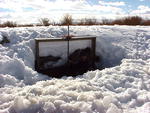 Sunday,
April 2 Rudy chopped six feet of ice out of the river headgate, so
we can divert some good stock water to the calving field. The chopping
job is tough and time-consuming; it will take yet another day to finish
the work. Sunday,
April 2 Rudy chopped six feet of ice out of the river headgate, so
we can divert some good stock water to the calving field. The chopping
job is tough and time-consuming; it will take yet another day to finish
the work.
Chopping
ice cont.
Monday, April 3 Rudy finished chopping out the headgate ice,
then cranked open the gates, so the water could begin its wild rush toward
the home meadow, two miles away.
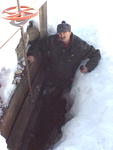
Canadian honkers
Tuesday, April 4 Lots of Canadian Honkers on the river. I love
to see them strut about and listen to their jabbering. The river stock
water still hasn't made it to the meadow because of the heavily iced up
irrigation ditches. Might take several more days to cut its way through.
Storm moving in
Wednesday, April 5 Very windy and scattered clouds. Storm moving
in from the West Coast. Very warm this afternoon. Snow settled a bunch.
Calving continues...
Thursday, April 6 Water made it to the meadow at last. Now, we'll
have to regulate its depth and flow to just a gentle, meandering stream.
Hard to maintain a consistent level with the cold nights and warm days.
Heifers are calving without much assistance - only a watchful eye. Hope
it continues. We are always thankful for every "free" calf (unassisted
birth). Don't want to have to do a Caesarian Section on any of the little
ladies.
BOVINE CAESARIAN
(The story of one ranch's operating room)
By Cris Paravicini
Julius Caesar entered this world by means of a surgical procedure named
for him - Caesarian Section or C-section. This technique might be referred
to as one of the most significant lifesaving methods used by mankind.
Caesarian sections are not used exclusively for the safe delivery of
human offspring. For many years ranchers have relied upon this procedure
to ensure the safe and successful delivery of their most saleable product
- beef cattle.
A lone heifer stands hunched beside the old pinewood barn. She wears
the suspicious mask of one troubled by the labor of birth. Other ladies-in-waiting
push their ballooned bellies into position at a nearby feeder for a timothy
and clover breakfast.
From an obscure position, the rancher and I observe the nervous heifer.
She starts to pace around the corral, rubbing her massive sides along the
pole fence. Her tasseled tail twitches like that of a cat about to hypnotize
the breakfast bird. A white, amniotic fluid-filled sack - her waterbag
- can be seen protruding from the birth canal. As it ruptures, one very
large hoof is seen projecting from the womb.
The rancher comments that one foot might be back. As the heifer lies
upon the frosty ground, her contractions strong and fast in a futile attempt
to give birth, a decision is made to manually aid the delivery of her calf.
An experienced rancher acquires a sixth sense in dealing with many tough
situations. He knows that within a short span of time, and after exhausting
normal means of extracting the calf, he might be performing a lifesaving
operation. The same procedure might have to be performed if the calf is
being born in the "breech" or "head back" positions and couldn't be turned,
or if the heifer's pelvic structure is too small to accommodate her progeny.
On this particular ranch, Caesarian sections occur on the average of
one or two every ten years. On ranches that are up-to-date on modern technology,
C-sections are rare occurrences. Application of a selective breeding program
improves herd genetics with respect to bone structure, low birthing weights,
high milk ratios, EPD's (Expected Progeny Difference). Common sense practices
of sound herd nutrition and selective culling, as well as selective replacing
of mother cows, serve to harvest a product with low maintenance and high
yield (money and weight).
Struggling to her feet, the mother-to-be is now being driven into the
dimly lit barn. Her quick, light steps and extended tail remind me of a
dainty lady stepping over a mud puddle. I notice that her eyes are glazed
and riveted in a fixed stare because of this new sensation of pain.
The operating theater is a sturdy boxstall in the far corner of the
barn. Even though fresh hay has been fluffed upon the floor, I inhale the
musty, sour smell of cow manure and urine that lingers in the damp, cool
air. The rancher and his hired man move quietly as they escort her into
the stall and snap the gate closed. A quick survey of our surroundings
reveals cobwebs swaying in the chilling draft. On the far wall a calf pulling
apparatus is suspended on 60-penny spikes. Old blood spatterings on its
many parts give the impression that this contraption originated in a medieval
torture chamber.
Now, the heifer must be maneuvered into an even smaller area constructed
with a hinged wooden panel that will restrict all movement when properly
adjusted.
Instead, she has plans of her own. Visibly irritated, the angered cow
rushes forward attempting to run full length of the men. A charging locomotive
would not instill more fear, so a rush of blood and a surge of adrenaline
create the primitive "fight or flight" effect. One slip of a cowboy's boot
while scaling the smooth logs of the boxstall walls cause a harrowing and
painful predicament for the man. During a Kodak moment like this, the cowboy's
backward glance reveals the image of the bovine animal that by nature does
not have top, front teeth, but suddenly she appears to have sprouted fangs
and is blowing fire from flared nostrils. Her long, pointed, sandpaper-like
tongue is protruding from a cavernous mouth that bellows distress signals,
heralding her inescapable predicament.
Unable to connect with human flesh, the heifer swings wildly into the
waiting confinement. A horse halter fashioned to fit a cow's head is slipped
into place and snubbed to the barn wall. Further movement is impossible.
By this time the rancher has rushed his hyperactive kids to alert his
wife of the impending surgery. "Tell your mom to see if the Procaine, that
numbin' stuff, is in-date. Bring lots of catgut and see that the knife
(scalpel) is sharp. Oh, yeh, tell her to bring the antiseptic soap, the
hemostats, some hot water and lots of clean rags; she knows what to get,"
he orders after them as they scurry over the last corral fence.
Electric shears slide down the cow's left side clearing soft puffs of
hair in preparation of the path that the knife will follow. "All hands
and the cook" arrive and enter the stall with brown paper bags and cardboard
boxes filled with supplies - a miniature mobile hospital unit. A 250-watt
light bulb is turned into a fixture to become the only source of light.
Some ranchers know this procedure entirely by feel, so lighting is of little
significance.
A quick pumping action of the tail locates the last vertebra in the
spine where five to ten milliliters of Procaine is administered epidural
style to halt labor contractions. My nose tingles with the smell of Lysol
and other aseptic solutions. Strangely, these odors have replaced the strong
scent of animal wastes.
The general surgical area is lathered with antiseptic soap and Betadine
solution and rinsed with water. Several thrusts of a needle and syringe
filled with Novacaine administered at the site of the "excavation area,"
will allow the procedure to accur painlessly.
The heifer begins to sway. The numbing agent is doing its job. The gate
is released so the animal can lie down if she chooses. The rancher and
his helpers grab the animal's tail and pull sideways to help her go down
with the left side upward. (Some surgeons prefer the right side, and some
prefer that the cow remain standing.) Her head is still halter-tied to
the wall.
Now the air is filled with blood-pulsing tension as the pace quickens.
I observe sweat beads forming on pinched brows. "Hand me the knife! Let's
get this calf out before it drowns," commands the man.
I watch in amazement as the rancher works deftly, hands steady like
those of a skilled surgeon slicing human flesh. I decide that both are
equally committed to a common cause - the preservation of life. Beneath
the mound of black hide exists a life-form that is at the mercy of the
man with the knife.
Soundlessly and smoothly like a skater's blade gliding across a mirror
of ice, the scalpel slides downward through the massive form. First layer
- the hide. Done. The subdural level is next. Done. Muscle tissue. Okay!
The uterus pushes upward from the pressure created by the surrounding organs
and intestines. Care is taken so that the contents do not spill onto the
boxstall floor. The uterus, normally a pear-shaped organ, is grotesquely
misshapen by the unborn form waiting within.
The assistants stare unblinking as the final incision is made. With
shirtsleeves rolled to the shoulder, the rancher plunges his hand into
the fluid searching for a hind hoof. The liquid splashes onto the man's
overalls and steam rises from the pool of life, as the search continues
for a limb to retrieve the helpless calf. A final examination of the "birth
bed" yields the much-sought leg. Tracing to its source assures the location
of its mate. The rancher pulls both feet from the womb and hands one leg
to his nearest helper. With an effort produced in unison, the two men pull
the calf from its mother's side.
Voices shout, "Shake it up and down so the mucous can drain!"
"Is it breathing?
Will it need CPR?"
"No, it's alive!"
"Great! I really didn't want to give the slimy, little thing mouth-to-mouth!"
Although mouth-to-nose resuscitation is intriguing to witness and extremely
successful in application, the new calf will not need it. The first, rattling
gasp for life has occurred during the shaking process. Already, the little
bull calf is trying to hold his head upright.
Attention is returned to the mother who will be sutured, filled with
antibiotics and left lying where she can see and smell her new calf. If
infection doesn't set in, and if she doesn't abandon her maternal instincts,
she'll forget the pains of surgery and proudly bring her healthy offspring
to the weigh scales in the fall.
On tiptoes we creep softly from the operating stage, like a parent proudly
leaving a sleeping baby's room. I reflect on what has just occurred and
conclude that livestock are a ranch's "bread and butter." They bathe in
pride and revel in the satisfaction of the battles they win, and learn
lessons from those that they lose. Chance makes them "jacks-of-all-trades."
Experience makes them "masters-of-many."
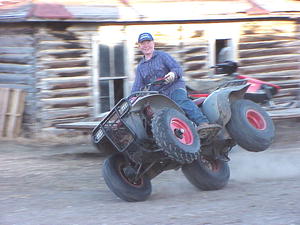
12-15 calves
each day
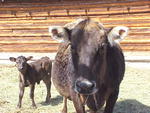 Friday,
April 7 Calves are being born at a rate of about 12-15 each day. This
number is just about right to care for and make sure that the little ones
are up and nursing, and feeling quite content with life. Heidi, the Brown
Swiss milk cow, gave birth to a "beige-colored" heifer calf early this
morning. Each year, I let her calve down in the pasture in her own familiar
territory, because she prefers the quiet and privacy of the willow patch.
After the calf was licked dry and had nursed, Rudy and I loaded it into
a little 4-wheeler cart, and with Heidi following, we transported the pair
to the barn where I began my twice daily milk maid duties. It will be 11
milkings until we can use her milk for human consumption. It takes about
that long (5-1/2 days) till the swelling, fluid, and colostrum in her bag
has subsided. We'll feed her extra colostrum to other needy newborns. Friday,
April 7 Calves are being born at a rate of about 12-15 each day. This
number is just about right to care for and make sure that the little ones
are up and nursing, and feeling quite content with life. Heidi, the Brown
Swiss milk cow, gave birth to a "beige-colored" heifer calf early this
morning. Each year, I let her calve down in the pasture in her own familiar
territory, because she prefers the quiet and privacy of the willow patch.
After the calf was licked dry and had nursed, Rudy and I loaded it into
a little 4-wheeler cart, and with Heidi following, we transported the pair
to the barn where I began my twice daily milk maid duties. It will be 11
milkings until we can use her milk for human consumption. It takes about
that long (5-1/2 days) till the swelling, fluid, and colostrum in her bag
has subsided. We'll feed her extra colostrum to other needy newborns.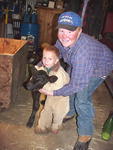
Dollar
Saturday, April 8 A horse trainer friend dropped off a bay, 3-year
old filly that he'd started. Her name is Dollar; she belongs to my sister
and brother-in-law. I'll ride her through the spring to give her some experience
with being around cattle and the open countryside, then they'll probably
sell her.
First gopher
of the year
Monday, April 10 We saw the first gopher of the year. The ground
must have thawed enough to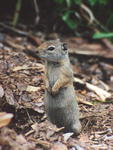 awaken the little varmints. Heard rumors that my bog frogs are thawing
out and are on their way upcountry! I took the little twin calf down to
the milk barn and let her get her fill on Heidi. My nephews have been helping
me bottle feed her whenever they come around, but by putting the calf onto
the milk cow, at this stage, it will remind her that she's still a calf
and not a human bottle baby. Then if we ever get a new mom for her (a cow
that loses her own calf for some reason), the twin will "graft" with greater
ease.
awaken the little varmints. Heard rumors that my bog frogs are thawing
out and are on their way upcountry! I took the little twin calf down to
the milk barn and let her get her fill on Heidi. My nephews have been helping
me bottle feed her whenever they come around, but by putting the calf onto
the milk cow, at this stage, it will remind her that she's still a calf
and not a human bottle baby. Then if we ever get a new mom for her (a cow
that loses her own calf for some reason), the twin will "graft" with greater
ease.
The sadder part
of calving
Tuesday, April 11 Our horseshoer came by about 8 a.m. to shoe
three horses. It was a warm, quiet morning, so the horses cooperated with
the inconvenience pretty well. They are veteran saddle horses and have
been shod many times before. While in labor during the middle of the night,
a big, heavy cow got on her back in an irrigation ditch. Sadly, by daybreak,
both the cow and calf were dead - a nice mama cow and calf gone, and a
$1,000 loss to the ranch. Such is this life.
Lightning
strikes the neighbor's haystack
Friday, April 14 I put another orphan calf onto the milk cow
this morning. This little heifer's mom was kicking her away - just up and
decided that she didn't want to be a mom after all. The spring weather
has made all the animals (and teenage bikers!) very frisky and full of
mischievous. Oh yes, those carefree, energetic days of youth! Thunderhead
clouds began forming in the mid-afternoon, and by early evening - accompanied
by our first shots of lightning - a cold, wet, sleet and hailstorm swallowed
the valley for about one hour. The sun did come out later, though, and
by dark had melted the one-half inch of slush. Luckily, it was warm going
into the night to stay above the freezing mark. We heard that our neighbor
lost a haystack (1000 bales) to a hot, destructive bolt of lightning during
this storm. What a way to start the summer season! But, thankfully, no
one was hurt, and our local volunteer fire department put out the fire
before it spread across the dry, grassy meadows.
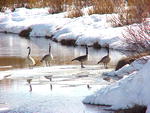
Nightly
heifer shift
Saturday, April 15 Most of the calves are looking fit and healthy,
soaking up the sunshine, and growing like the dandelions that are sprouting
everywhere. Little shoots of green grass are trying to get a foothold,
wherever there's some protection from the still frosty nights. The full
moon has been peaking through the cloud coverage around midnight - my last
heifer shift before bedtime - and the star constellations are absolutely
brilliant. So bright, in fact, that they seem alive, twinkling and laughing
in great delight. I always pause for a little while on my way home each
night just to stand and gaze at this majesty.
Bum calves
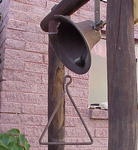 Sunday,
April 16 Still have two bum calves doing the timeshare thing with the
milk cow and her calf. Yesterday a little calf was born in the older cows
with some health problems. It has an extended, spongy belly, and probably
won't live, so its mom will become a foster mother candidate to one of
my bum babies. Sunday,
April 16 Still have two bum calves doing the timeshare thing with the
milk cow and her calf. Yesterday a little calf was born in the older cows
with some health problems. It has an extended, spongy belly, and probably
won't live, so its mom will become a foster mother candidate to one of
my bum babies.
Jack Snipes
Monday, April 17 Early this morning, I had to smile as I did
my chores. Not only can I now 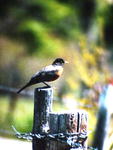 enjoy
the Robin Redbreast's first chorus of the day, but the Jack Snipes, too,
have finally returned with their unique wing whistle, "Whooo, whooo, whooo,"
as they dive through the damp and cloudy, morning air, catching the brave
first-of-the-season flying insects. enjoy
the Robin Redbreast's first chorus of the day, but the Jack Snipes, too,
have finally returned with their unique wing whistle, "Whooo, whooo, whooo,"
as they dive through the damp and cloudy, morning air, catching the brave
first-of-the-season flying insects.
Cut dry
cows
Tuesday, April 18 Saddled up and cut dry cows (cows that have
either lost a calf or are barren (dry) this season) away from the cows
and calves. These "unemployed" gals (having nothing better to do with their
time) tend to harass and trample through the new babies. This creates a
nuisance and a great risk of hurting or confusing the newborns and their
moms. Therefore, we simply cut them into a field where they'll finish the
feeding season all by themselves. Also, we moved some of the older cow/calf
pairs into a nearby, fresh meadow. Scattering them out helps keep down
scours and other illnesses, and helps keep the moms and kids from mixing
up and causing trouble.
Where are
the Bog Frogs?
Wednesday, April 19 Dang it. Still no bog frogs to sing their
hearts out to me. Soon, soon, I hope!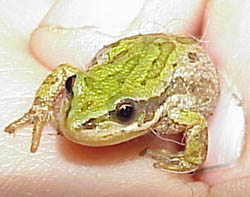
Bog
Frogs wake up!
Thursday, April 20 Yes! This afternoon, a couple of frogs finally
awakened from the long winter's nap! We were checking the calves in the
meadow when I heard that familiar and beautiful frog harmony in a nearby
slough. It sure made me smile.
A very HAPPY EASTER to everyone!
3 weeks
ahead of schedule
Sunday, April 23 Very nice weather today: lots of sunshine, no
wind, and quite warm at about 60 degrees. Our season is about 3 weeks ahead of schedule.
degrees. Our season is about 3 weeks ahead of schedule.
Sage Chicken
"Bombers"
Tuesday, April 25 Sage chickens (we call 'em "bombers" because
they fly so low and slow and seem barely to hang in the spring air) are
making their annual migration back to our area.
Dragging
Wednesday, April 26 Started dragging the meadows and pastures
this a.m. We pull/drag a heavy, 25-foot contraption behind a tractor to
spread a year's supply of cow manure into an evenly distributed form of
natural fertilizer. This really makes the new grass grow thick and lush.
Now we need a warm, gentle 24-hour rain drizzle to help the hay crop get
a perfect start.
Dragging
cont...
Thursday, April 27 Dragging meadows all afternoon at Horse Creek,
again. Very windy and dusty - choking, powdery alkali is boiling and burning
my nose and eyeballs. Storm clouds trying to get it together on the western
horizon.
Cris-kabob
Friday, April 28 Another one of those dragging days on Horse
Creek. But, the job is so peaceful, with lots of time to think and plan
the days yet to come. I steered the tractor past an empty haystack pen,
and laughed to myself as I recalled last year's encounter with a nesting
sandhill crane. The momma was setting on her nest in a stand of dry cattail
leaves. I didn't see her before she spotted me. When I got close to the
fence, she jumped up, and instead of running away, big momma sprang into
the air on long, limber legs that looked and performed like well-oiled
coil springs. Whoa! Michael Jordan, eat your heart out - that ol' girl
could jump! When she landed, she was on my side of the fence, and I swear
that if birds had teeth she danged sure was gnashing hers - at me. All
of this happened in bursts of split seconds, and me - well, I'm still driving
toward her, trying to decide which way to go so I won't rile her even more.
Still, the massive bird continued her mad, determined advance, charging
headlong toward the Massey Ferguson tractor and me. Mother Crane's long
neck was outstretched like a long piece of uncooked spaghetti, and her
very long, very sharp beak put the sharp tip on one very upset "spear."
I knew she was planning to make a shish kabob of me! By now, I had responded
and wheeled the tractor away from the stackyard fence, looking over my
shoulder the whole way. But still, she rumbled after me, wings spread,
eyes like black holes, and fully zeroed in on her target. I'd just about
come to the conclusion that I was facing a motherly instinct and fury beyond
what I'd ever seen before, when she stopped dead in her tracks and headed
back to her nest - probably holding 2-3 eggs, I would guess. I sure didn't
try to count 'em. Needless to say, I left "her" piles of cow poop alone,
and detoured around the nest for the rest of the day.
Still
calving
Saturday, April 29 Still calving right along. Every day we cut
out cow/calf pairs into fresh fields. The little fellas are really growing
and thriving this season, and branding time is creeping up fast.
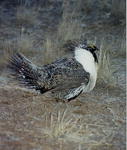 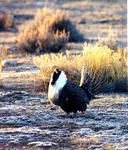 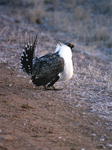
Sage Roosters
|